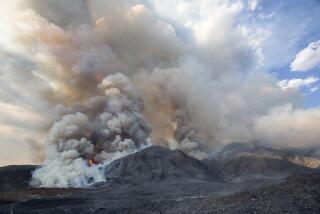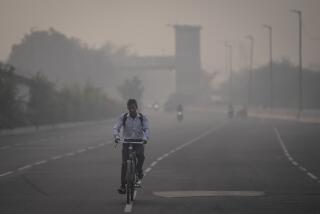Op-Ed: The carbon that’s killing India, and how California can help

This week, President Obama is the chief guest of Prime Minister Narendra Modi at India’s Republic Day celebrations. At the close of the historic visit, the two leaders are expected to announce cooperation on a suite of climate and clean energy measures, with the ultimate goal of reining in India’s rapidly rising carbon dioxide emissions.
But during his visit, the president, just like New Delhi’s 25 million residents, will be exposed to another kind of dangerous carbon pollution: black carbon.
Black carbon is scientists’ term for ultra-fine particles produced by incomplete combustion. It’s the stuff that makes soot dark, an unwanted byproduct of burning diesel fuel in vehicles, biomass in stoves for cooking and heating, coal in small industrial operations and agricultural waste in post-harvest fields. Humanity sends as much as 17 million metric tons of black carbon each year into the atmosphere, where it traps far more heat per unit mass than carbon dioxide, making it the second-biggest contributor to global warming.
It’s also a major constituent of the pollution that is now choking New Delhi. On a typical day, the Indian capital has the worst air quality of any city in the world, according to a recent U.N. report. But the air is particularly bad this time of year, as particles are trapped by cold, dense fog. So there’s a good chance the president will have a hard time seeing the celebration through all the haze. On last year’s Republic Day, particulate matter under 2.5 microns in diameter, which penetrates deep into human lungs, spiked to 15 times the level deemed safe by the U.S. Environmental Protection Agency.
In addition to pursuing a strong bilateral agreement to start ramping down carbon dioxide emissions, the U.S. should pursue an equally ambitious partnership to help purge India’s skies and lungs of black carbon. Although we’re all at risk from this pollution to varying degrees, India is perhaps the country most vulnerable to black carbon’s effects.
By absorbing sunlight and turning it to heat, black carbon melts the Himalayan glaciers and snowfields that hundreds of millions of Indians depend on for irrigation and drinking water. It disrupts the South Asian monsoon, which is so important to the region’s agriculture that one former finance minister called it India’s “real finance minister.” It is a major ingredient of the household air pollution from burning wood and dung for cooking that kills more than 1 million Indians each year. Meanwhile, black carbon and other fine particles in outdoor air pollution kill more than 620,000 Indians annually, and cause $18 billion in economic losses from damage to agriculture and health.
The conventional framing of India’s climate options as a zero-sum game — aggressive mitigation action versus expanding economic opportunity — presents a false choice. There’s a path ahead that combines enormous economic benefits with rapid reductions of climate-warming pollution. India’s dependence on kerosene for lighting, solid fuels for cooking and heating, high-sulfur diesel fuel for transport and inefficient coal combustion for brick making and power generation is killing almost 2 million Indians each year — and robbing many millions more of healthy years of productive life. Tackling these sources of black carbon and carbon dioxide would be a potent boost to its economy.
The U.S. can develop innovative financing mechanisms and share deep technical expertise in developing and deploying cleaner-burning technologies with agencies and research institutions in India. A wider black carbon program could be modeled on the ongoing India-California Air-Pollution Mitigation Program, which seeks to leverage California’s experience in dramatically reducing black carbon emissions from diesel transport, to help India shift to more efficient, lower-emissions forms of transport, and to devise tighter new vehicle emissions rules and better enforce existing ones. This approach has cut soot concentrations in California’s air by 90% since 1966.
On the docket should be common-sense measures such as accelerating distribution of ultra-low-sulfur fuel throughout India, which would enable the widespread use of black carbon-trapping diesel particulate filters. One study found this switch would create $484 billion in health and fuel savings by 2030. Other targets for acceleration include clean-cooking-stove research and distribution programs, and an all-out effort to eliminate the use of kerosene for lighting. Viable alternatives to kerosene lamps exist, such as solar lanterns and solar micro-grids, but businesses that manufacture and distribute them are starved for funds to scale up.
As California has learned, clean air unlocks economic potential. And reducing black carbon will clear skies and cool the climate almost immediately. If the U.S. has its partner’s best interests in mind, it will work with India to accelerate its transition to a development path that is low-carbon in every sense. Then, perhaps on a Republic Day in the near future, celebrants will have a clear view of the vast potential of India’s people.
Jonathan Mingle is the author of “Fire and Ice: Soot, Solidarity and Survival on the Roof of the World,” to be published in March.
Follow the Opinion section on Twitter @latimesopinion
More to Read
A cure for the common opinion
Get thought-provoking perspectives with our weekly newsletter.
You may occasionally receive promotional content from the Los Angeles Times.






